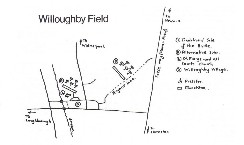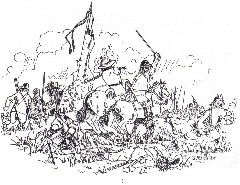THE CAMPAIGN
The Royalist uprising of 1648 saw the re-occupation of Pontefract Castle and town for King Charles on June 3rd . The limited supplies available in the town forced the evacuation of some 300 horse in the middle of that month. Commanded by Sir Philip Monkton, Gilbert Byron and Michael Stanhope this force moved to Doncaster. A few days later - now reinforced to about 500 Horse, Foot and Dragoons, they moved to the Isle of Axholme in North-West Lineon-shire and plundered it. Meeting little resistance the Royalists moved on and, by friday 30th June, had occupied Lincoln.
[1]
The Parliamentarian forces had been concentrating on the main threats in South Wales and South-East England. With most of the troops eventually being tied down in the Sieges of Colchester and Pembroke there was little in reserve to counter the Royalists in the Midlands. A Captain Poulton had a small force in Nottingham Castle, Col. Henry Markham a handful of Horse in Belvoir Castle.
The attempted (and unsuccessful) bribery of Poulton by Col. Byron and an abortive attempt to surprise Nottingham Castle alerted Parliament to the situation. A sum of £500 was voted for the repair and fortification of the castle, a new troop of horse to be raised for its defence. Col. Edward Rossiter was in charge of organising the defences of the threatened area. The Parliamentarian County Committees of Nottinghamshire, Berbyshire, Lincolnshire Leicestershire, Rutland and Northampton were urged to send all available troops to serve under him, but the levies were slow to arrive. Not being able to support the 800 men loosely blockading Pontefract Rossiter set up headquarters at Belvoir Castle, occupied Newark and tattershall castle in order to cut the road south but sent not help to Lincoln. He heard of its fall a few hours after its capture.
Sending for troops from the surrounding Shires, by the evening of July 2nd he had 5-600 Horse, including a strong contingent from Nottingham under Colonel White and Capt. Champion. The next day he set out for Lincoln, collecting reinforcements as he went.He arrived that night at Waddington Fields - within 3 miles of the City - only to discover the Royalists had left on the 1st. They had marched to Gainsborough, their numbers swelled by many Lincoln volunteers.
However, Sir Henry Cholmley, with 600 Yorkshire Horse and Dragoons, managed to head off the Royalists, forcing them to turn south towards Newark. Unaware of this Rossiter marched on Tuesday 4th towards Gainsborough.He eventually discovered Monkton's position from a prisoner who had escaped from the Royalists. About this time he may have also contacted Cholmley for they now moved down both sides of the Trent in pursuit. With his more mobile force Cholmley was to intercept the Royalists if they turned to cross the river and return to Pontefract.
That night Rossiter and his men rested in a meadow a mile from Newark. Here he was joined by 150 men from Derby, Lincoln, Leicestershire and Rutland. He also learnt that Monkton was quartered at Bingham, 10 miles on. Monkton's apparent aim in pushing south was to reach Kegworth or Loughborough were he had hopes of support from Derbyshire and Leics Royalists. But behind him was Rossiter. To the South Lord Grey of Groby and the Leics. Militia were blocking the bridge across the Soar near Loughborough. To the North was Cholmley. On Wednesday the Royalists moved south down the Fosse Way. They stopped to plunder Col. Hutchinson's house at Owthorpe [2] but were overtaken a mile or so along the road near widmer-pool. A running skirmish began for 2 miles between an advance guard of 150 horse under Cpt Champion and the Royalists. Monkton finally turned on hispunsuers in a large bean-field just north of Willoughby Church. Maybe the pressure of Rossiter's force made them turn - or perhaps Monkton resolved to try to crush Rossiter before Cholmley of Grey could arrive. [3]
THE BATTLE
Monkton was obliged to put all his men in the fighting line, dispencing with any reserve His Centre consisted of the best troops, flanked by Horse who were in turn flanked by musketeers. The force totalled around 800 Horse and Foot. Their Field Word was 'JESUS'. [4]

Large Map of the Battle of Willoughby Field

Rossiter's men formed up opposite. They were led on the right wing by Col. White (Notts. Horse) and on the left by Col. Hacker (Leics. Horse). Rossiter himself led the main 'battle' in the centre. There were also two bodies in reserve. Consisting entirely of Horse, the Parliamentarians numbered between 800 and 900. Their Field Word was 'FAIRFAX'. [5]
The Parliamentarian accounts say that Rossiter charged first, though Monkton states that his men forced those thay charged to recoil. Both sides may have advanced together, neither wishing to bet caught at the halt.Things soon developed into a 'soldiers battle' with both lines locked in a fierce melee. The Royalists were at first successful, pushing Rossiter back. He was shot through the thigh, also having his helmet knocked off in the fight. The Cornet of Rossiter's own troop was killed and his colours taken until a Reformado officer, Cornet Ridgeley, managed to recover them.
With the advance of the Parliamentarian reserves the battle was won, the Royalists breaking and fleeing. Monkton's own account relates that "though we forced those we charged to recoyle yet his reserves stood firme and advanced upon us, and routed us beeing disordered with the charge wee made upon his first line, which fought obstinately" Sir Philip Monkton and Col. Gilbert Byron were taken prisoner. (Monkton was in fact still recovering from a wound in his right arm he received at Rowton Heath). Over 100 Royalists were killed, including Cols. Chomley (no relation!) Edward Packlington and Michael Stanhope. [6]. Besides these losses there were 36 officers captured "besides several other officers amongst the common soldiers who will not yet discover their qualities". Also 44 Gentlemen of quality, 500 soldiers, many wounded, 10 colours of Horse and Foof'where of the greatest part in cloke bagges not delivered out" 1 waggon and 7 carriages with arms, ammunition, baggage and 400 horses (100 Royalist horses being killed).
On the Parliamentarian side, Rossiter, Hacker and White were all wounded. So as not to discourage his men, Rossiter had remained on his horse until the battle was over. They lost 30 killed. The highest officer killed was Rossiter's cornet. Capt. Greenwood of the Derby troop was badly wounded. Lieut. Deane of the Belvoir Horse was slightly wounded. Apart from Taylor's troop and some of the Belvoir Horse, most of Rossiter's men were newly raised on recently purchased horses. Parliamentarian sources state that not one of them "who were strangers to such hard service, was observed to turne his backe during the whole brunt"
Many of the Royalists were later rounded up by Lord Grey and his Leicester troops. In fact an hour after the battle two troops of Horse arrived from Northampton. In the confused marching of the previous days they had failed to find Rossiter. Having missed the fight they joined in the pursuit.
The defeat was total. Rossiter had crushed the hopes of the Midland Royalists and localised the insurrection to the immediate area around Pontefract. He had prevented any assistance reaching Colchester and had cleared the way for Cromwell's unhindered march through Nottinghamshire and Yorkshire in August to meet and defeat the Scots at Preston. Well might Parliament send a physician and surgeon to attend him, and vote him 12,000 [7] out of the sequestrations. He was also personally thanked by the Speaker for his well earned victory.

NOTES
[1] A Captain Bee with 50 men defended the Bishop's Palace for some 5 hours until the Royalists fired part of the building. Bee surrendered on terms. Ihe terms were broken, Bee siezed and carried off as a prisoner He was released after Wllloughby Field.
[2] The Governor of Nottingham had little time to send a message to Col. Hutchinson (the former Governor) of Monkton's approach. He instead fired a cannon which Hutchinson heard. Riding to Nottingham to find out what was happening Hutchinson met a messenger sent to tell him of the Royalist's proximity. He thus managed to save his valuables, though 2 horses were taken. The house was saved from damage by Col. Byron. This kindness was returned . Hutchinson sent him a gift of money while Byron was a prisoner in Belvoir. He later secured his release.
[3] There are two sites suggested for the battle.
The traditional one is the meadow near the church. Against this is the argument that an experienced leader such as Mokton would not have chosen ground with the slope against him and a stream behind him. Moreover,if he had have been near the church it would have been better to place his foot in the buildings as better protection against Rossiter's Cavalry force.
However, Honkton was involved in a running skirmish and may not have had time to carefully pick a battle site. Secondly, the skirmishing started at Widmerpool. The road from there to Willoughby runs past the traditional site. Thirdly, local tradition has it that the locals looked down on the battle,implying the meadow beside the church. Lastly it might have been that Monkton had already left the Fosse Way and was heading towards Kegworth or Loughborough when Champion caught up with him at Widmerpool. Country lanes lead from there to the two towns, but Champion may have forced him towards Willoughby.
The alternative site is an old trackway called Bryans (or Bakers) lane. This leads across level ground to Willoughby from the Fosse Way. Having cone from the Fosse the Royalist were caught at Widmerpool crossroads - not the village. Skirmishing down the Fosse the Royalists would have had to turn off west to Loughborough or Kegworth so they used Bryan's Lane. The fight took place on or near this lane. After the first impact the fight swayed towards the village, the country lanes givinga line of retreat for the broken Royalists. Any fighting in the Meadows was merely the result of pursuing Parliamentarians catching up with their enemy. There is a mob lane (narrow alley) in the village where tradition has it the soldiers ran - this would suit the alternative location well.
[4] Rosslter thought Monkton had 1,000 men. Firth, in his edition of the Hutchinson Memoirs, says 7-800. The total prisoners, killed and escaped Royalists is ibout 800 "about 200 that were best horsed (whereof diverse Papists) got off in small parties" - 100 Killed; 36 officers and 500 men taken; 200 escaped.
[5] Rossiter had 550 men when he left Belvoir on Jule 3rd.He was joined by 50 lynn Horse and by 150 from Newark Though making 750, Monkton states that Rossiter so outnumbered him that to match his line he had to put evryone in the front but the latter had enough left over for a reserve. Thus either Rossiter had received unkown reinforcements or Monkton's figures were inflated in the accounts.
[6] He was buried in Willoughby Church. An oval plate in the floor reads - Here lyes the body of/Collonell MICHAEL STANHOPE/who was slayne in Willough-/by Field in the month of/July I6"i8 in the 2Uh/yeareof his age being/ a souldier for King/Charles the first.
[7] Captain Norwood was voted £100 for bringing the news and commanded to write an account.
NB Monkton was reported to have taken some dragoons with him when he moved to the Isle of Axholme. There appears to be no evidence which suggets they were with him at Willoughby, unless some of his musketeers were dragoons.
SOURCES